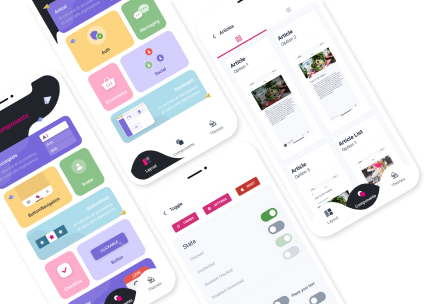Top 4 Mobile App Development Frameworks In 2021
Choosing the right mobile app development framework and application development strategy is one of the most important steps in the mobile application development process. A process which is becoming increasingly more complicated due to the sheer volume of approaches and mobile development frameworks available these days.
Whether you are an experienced developer, an established business or a start-up working out what is most appropriate for your needs, we hope that this article will help you navigate the options available to you. At Groove Technology – we have years of experience in Mobile App Development – and we hope our experience will help you find the answers you are looking for.
Don't forget to contact the mobile app development team at Groove Technology to make your plan a reality.
Now let's take a look at some of the mobile application development framework trends in 2021
What is a mobile app development framework?
Because IOS and Android are two completely different technologies, developing a single app capable of running natively on each has traditionally meant developing and maintaining two separate codebases. The cost building an app to run on each platform using the traditional native approach is often up to 250% of the costs for developing for just one.
With the strength of being able to run on both iOS and Android platforms with just one codebase, a cross platform mobile application development framework helps to reduce the development time and costs of mobile applications significantly giving you a great deal of flexibility.

Top 4 Mobile App Development Frameworks
React Native
React Native was originally built by Facebook and has since become the best mobile application development frameworks for people looking to build for both IOS and Android and has become favorite among mobile app developers.
As the top cross platform mobile application development framework React Native was used to develop many of the top applications used today including Facebook, Instagram, AirBnB, Skype, Uber Eats, Shopify, Salesforce and many many more.
At Groove Technology, our mobile app development teams have used React Native exclusively which has allowed us to deliver superior outcomes for our customers at a lower investment in cost and development time.
Read more: Why use React Native for your mobile app?
Features:
- Time-efficient.
- Stable Performance.
- Strong Community.
- Cost Savings.
- Fast and Reliable.
- A consistent experience across device types.
- A native equivalent user experience.

Ionic
Ionic is a widely used framework which has quickly become a favorite choice of some mobile development teams thanks to its support for application development on iOS and Android. Ionic combines CSS, HTML, JavaScript to a provide a hybrid mobile and web application experience.
Mobile and web application developers can use common UI elements such as list views, filters, forms, action pages, navigation menus, and tab bars and apply them to both mobile and web. Done properly, this allows Ionice to provide a consistent user experience across Web, Progressive and Mobile apps.
Ionic is a good choice for developing modern web, mobile, progressive and hybrid applications.
Features:
- Intuitive user interface components.
- Easy and fast to develop.
- Cordova plugin.
- JavaScript components.
- Frame compatibility.
- Strong community support.
- Complete control over app building.
Xamarin
As a mature cross-platform application development framework developed by Microsoft. Xamarin helps development teams create mobile applications for Android or iOS using the Microsoft .NET Framework and it’s C# language.
Xamarin is an abstraction layer that manages communication of shared code with underlying platform code. Xamarin runs in a managed environment that provides conveniences such as memory allocation and garbage collection.
Xamarin allows developers to share 90% of their apps on average across platforms. This model allows developers to write all their business logic in a single language (or reuse existing application code) but achieve native performance, look and feel on each platform.
The flexibility of native performance helps many businesses deliver a unique experience to their users.
Features:
- Reuse code many times, reducing time for applications on multiple platforms.
- Performance is almost native.
- Supports all hardware.
- Many libraries to support applications are available.
Flutter
Flutter is Google's free, open-source mobile UI framework that also allows development teams to create native equivalent mobile applications with just one codebase. This means you can use one programming language and one codebase to create two different apps (for iOS and Android).

With the UI toolkit, using the 2D graphics library (Skia), the visual aspects of the application are further enhanced. Flutter is natively translated for many different devices across a single code base.
Featured:
- High productivity, helping to save time and money.
- Comparable performance.
- Strong Documentation.
- Compatibility by widgets that are part of the application instead of the platform, time spent testing less than other application frameworks.
- Broad Community.
The frameworks that I mentioned above have dominated this TOP 10 list for many years and 2021 will be no exception. Well, what if you are reading this article, some new framework will come out? Technology is evolving day by day!
If you need any support, Groove has the solution for you!









